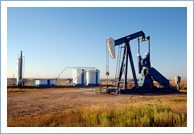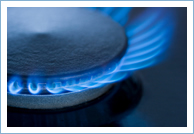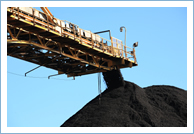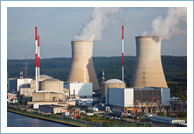KPDSB and CUPE Local 1939 Reach Tentative Settlement
09 Jun. 2023
File a report now.
Apply today.
Non-renewable sources cannot be created over and over again and our supply of them is limited. Once they run out, the resource is gone forever. Non-renewable energy sources include oil, gas, coal and nuclear energy.
Fossil fuels are the primary commercial energy source in the world today. The geologic processes that created fossil fuels are no longer occurring at a rate useful to humans, so these fuels are limited and are therefore classified as non-renewable resources.
There are three major forms of fossil fuels:
Fossil fuels were formed many millions of years ago, before the time of the dinosaurs (hence the name fossil fuels). The age in which the fossil fuels were formed is called the Carboniferous Period. It was part of the Paleozoic Era. Carboniferous gets its name from carbon – the basic element in coal and other fossil fuels.
As the trees and plants of the Carboniferous Period died, they sank to the bottom of the oceans where they formed layers of a spongy material called peat.
Over many hundreds of years, the peat became covered with sand, clay and other minerals, which over time transformed into a layer of sedimentary rock.
Over the following millennia, surface materials continued to build up and increase pressure on the carboniferous layer, eventually changing the material into the kind of fossil fuels we use today.
Oil and natural gas are found underground between folds of rock and in areas of rock that are porous.
To find oil and natural gas, companies drill through the earth to the deposits deep below the surface. The oil and natural gas are then extracted from below the ground by oil rigs and shipped to a holding terminal for redistribution or refining.
What is oil?
Oil is also called petroleum or crude oil. The word petroleum comes from the Greek word petra (rock) and the Latin word oleum (oil). It is a naturally occurring, flammable liquid found within layers of rock formations beneath the Earth's surface. It consists of a complex mixture of hydrocarbons and other liquid organic compounds. Once extracted, oil refineries split crude oil into various types of products by heating the raw oil so that the hydrocarbon molecules can be separated by size. This process is called cracking.

Most processed crude oil is made into energy products such as gasoline, diesel fuel, aviation or jet fuel, home heating oil, oil for ships and oil to burn in power plants to make electricity.
Crude oil is also used to create many of our fertilizers, pesticides and plastics. The clothes you wear, the toothbrush you use and the plastic bottle that holds your milk all came from oil.
How do we use oil?
To produce electricity. Three technologies are used to convert oil into electricity.
a. Conventional steam
Oil is burned to heat water to create steam to generate electricity.
b. Combustion turbine
Oil is burned under pressure to produce hot exhaust gases, which spin a turbine to generate electricity.
c. Combined-cycle technology
Oil is first burned in a combustion turbine, using the heated exhaust gases to generate electricity. After these exhaust gases are recovered, they heat water in a boiler to create steam to drive a second turbine, or they are used for heating purposes.
What are the environmental impacts of oil?
Whenever a fossil fuel is burned, carbon dioxide (CO2) is produced. CO2 is a greenhouse gas responsible for climate change.
Burning oil to generate electricity produces significant air pollution in the forms of:
Oil-fired power plants also impact water, land use and solid waste disposal. Oil-fired conventional steam plants require large amounts of water for steam and cooling, and can harm local water resources and aquatic habitats. Oil residues and sludge that are not consumed during combustion contain toxic and hazardous wastes that are dangerous to the environment.
Drilling and extraction of oil produces:
Oil exploration and drilling also disturb wildlife habitats, water and land. Finally, oil transportation accidents such as tanker spills can result in catastrophic damage to wildlife and wildlife habitat.
What is natural gas?
Natural gas is a form of petroleum, consisting primarily of methane - the lightest of the hydrocarbons. Because it is a gas, natural gas is harder to handle than liquid oil or solid coal, and the most efficient means of containing and moving natural gas is through pipelines, which are built to connect the gas fields directly to major urban areas. Gas can also be compressed in tanks and moved about as liquefied natural gas (LNG).
Liquefied petroleum gas (LPG) is a product of oil fields. Although it is a mix of several gases, it is commonly called propane. LPG is found dissolved in crude oil. It is separated from the liquid oil and stored under pressure in heavy metal cylinders. These containers can easily be transported to homes for use in heating and cooking. Like natural gas, propane is a relatively clean burning fuel and produces few contaminants.
Like oil, natural gas is found underground and under the ocean floor. Wells are drilled to tap into natural gas reservoirs. Once a drill has hit a pocket of natural gas, it can be pumped to the surface like oil.
How do we use natural gas?
Natural gas provides a cleaner burning, less expensive alternative to oil and electricity. The percentage of homes and buildings heated by natural gas is steadily increasing. Today, over 40% of Canadian homes are heated by natural gas.

Natural gas, like other fossil fuels, can be used as a fuel in conventional steam boiler generators.
Newer technologies such as combustion turbines can significantly reduce fossil fuel consumption. Based on jet engines, combustion turbine technology uses superheated gas which is pressurized in pipes and used to drive the turbine. Waste heat from this process is used to heat steam and power a second generator. This boosts efficiency by as much as 40%.
A process called co-generation further increases efficiency. A fuel source such as natural gas is used to create electricity and the waste heat is used for residential or commercial heating.
What are the environmental impacts of natural gas?
Natural gas has a significantly smaller environmental impact than oil and coal. Burning natural gas combustion generates about half as much carbon dioxide as burning coal. It also produces less particulate matter, sulphur dioxide and other toxic emissions. However, burning natural gas may produce nitrogen oxides and carbon monoxide in quantities comparable to burning coal.
Ongoing use of natural gas inevitably results in methane emissions. Methane is a very potent greenhouse gas contributing to global climate change.
Like oil, natural gas drilling and exploration can have a negative impact on wildlife and wilderness habitats.
Why is natural gas considered a cleaner source?
Methane is a simple c-h molecule with few impurities. The combustion of natural gas is much cleaner than the combustion of oil and coal. It produces substantially lower nitrogen oxide, carbon dioxide, particulate matter and sulfur dioxide emissions. Natural gas is considered by some to be a transition fuel, as the energy supply moves away from polluting sources, such as coal and nuclear, towards cleaner, renewable sources.
Did you know?
What is coal?
Coal is a hard, black rock-like substance that is made up of carbon, hydrogen, oxygen, nitrogen and varying amounts of sulphur. There are three main types of coal: anthracite, bituminous and lignite. Anthracite coal is the hardest and has the most carbon, giving it the highest energy content of the three. Lignite is the softest and is low in carbon but high in hydrogen and oxygen. Bituminous coal properties lie between the other two.
Coal is mined from the ground using underground mines and strip mines. Strip mines use huge shovels to strip away the layers of earth above the coal in order to remove it.

Most coal is transported in its solid form either by train or by boat. In some cases, pipelines are used to connect coalfields directly to electric power plants. In these instances, the coal is mixed with water and moved through the pipeline. The creation of this mixture, commonly referred to as slurry, can generate considerable water pollution.
How do we use coal?
Coal’s biggest use in North America is to generate electric power. Coal-fired generators produce over half of the electricity used in the United States. Industry uses large amounts of coal, mostly as a mixture called coke in iron and steel manufacturing. A very small amount of coal is used directly in houses and commercial buildings as a fuel source for heat.
Over 80% of Canada’s domestic coal consumption is in electricity generation. Of the country’s total electrical generation, coal accounts for 16%.
What are the environmental impacts of coal?
There are a number of serious environmental problems with the use of coal, from mining to the end-use.
Strip mining, for instance, destroys wildlife habitat and soil. Transporting and processing coal affects water systems for both aquatic life and humans. Mining coal releases methane gas, which is a greenhouse gas and contributes to climate change. Other greenhouse gases, such as nitrous oxide, are also released in coal production and use.
Coal also contains heavy metals like mercury which are released into the atmosphere when burned. Heavy metals are very toxic to both humans and animals, especially if they get into our food or water systems.
Some technologies have been developed to try and reduce these environmental impacts.
Modern coal-burning technologies create a pressurized fluid and blast hot air into the pulverized coal dust to create a floating burning environment. This process allows for higher burning efficiency at a lower burning temperature and results is decreased NOx generation. Sulphur-absorbing limestone can be added to the coal mix to remove the pollutant and create calcium sulphate, the base material for dry wall.
Treatment of the flue gases using catalysts and scrubbers can further remove significant quantities of pollutants.
Did you know?
Coal-fired electricity plants are responsible for a significant proportion of Canada’s poor air quality during the summer. Coal is a major generator of electricity in the Maritimes, Alberta, Ontario and Saskatchewan. Some provinces, like Ontario, are closing their coal-fired power plants while others, like Alberta, continue to build new coal plants.
What is nuclear energy?
Nuclear energy is energy that is released when an atom is split. A tremendous amount of energy is released in the form of both heat and light when an atom is split. This energy, when controlled, can be harnessed to generate electricity. Like fossil fuels, the uranium used to fuel nuclear power plants is a mineral of limited quantity, and thus non-renewable.

How do we use nuclear energy?
Nuclear energy can be used to produce electricity. Inside the reactor of an atomic power plant, uranium atoms are split apart in a controlled chain reaction. Neutrons bombard an atom of uranium-235 which then splits and forms two new elements plus two more neutrons. These new neutrons then go on to split more atoms in a chain reaction.
This chain reaction gives off heat energy. The heat is used to boil water in the core of the reactor. The heat is transferred into a separate, radiation-free hot water system via a heat exchanger. The steam in this second set of pipes turns a turbine to generate electricity. Gases are also sometimes used as the heat transfer medium.
What are the environmental impacts of nuclear energy?
Some people tout nuclear power plants as a clean electricity source since the nuclear plants themselves do not release any of the usual power generation air pollutants, such as sulphur dioxide, carbon dioxide or nitrogen oxides.
However, getting the uranium needed for nuclear power plants results in other environmental impacts, including air emissions. Another important environmental impact of nuclear energy is radioactive waste.
Radioactive wastes occur at all stages of the nuclear fuel cycle. The process of producing electricity from nuclear materials involves:
While the amount of solid wastes generated at nuclear plants is relatively small, these radioactive wastes pose health risks that exceed that of any other source of electricity. A typical 1,000 megawatt (MW) reactor produces 20-25 tonnes of spent fuel per year. If this spent fuel is not reprocessed, it can pose radioactive risks for as long as 250,000 years. The storage of that highly toxic waste remains unresolved.
In addition, nuclear plants that rely upon water for once-through cooling systems require two-and-a-half times as much water as a typical fossil fuel plant. The impact on water resources, aquatic habitats and fish is therefore more significant with nuclear power plants than with any other power generation technology (with the possible exception of hydro-electric facilities themselves).
Did you know?
- Canada is the world’s leading producer of uranium, accounting for slightly less than one quarter of total world production. Ranking seventh in the world, the country’s nuclear power plants currently supply about 15% of the electricity produced in Canada.
- In the nuclear fuel processing process, the uranium enrichment process depends on great amounts of electricity. Most of this electricity is provided by dirty fossil fuel plants responsible for all of the usual air pollution emissions that are not released by the nuclear reactor itself.
- Two of the most polluting coal plants in the United States produce electricity primarily for uranium enrichment.
Nuclear fuel processing also produces radioactive wastes, which must be adequately stored and removed to minimize the risk of radioactive contamination.- Half a kilogram of uranium-235 can generate 3 million times as much electricity as the equivalent mass of coal. At the molecular level, one atom of uranium-235 produces 25 million times as much energy as one molecule of methane.